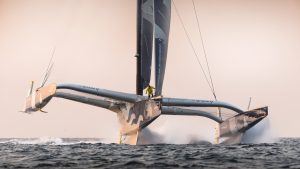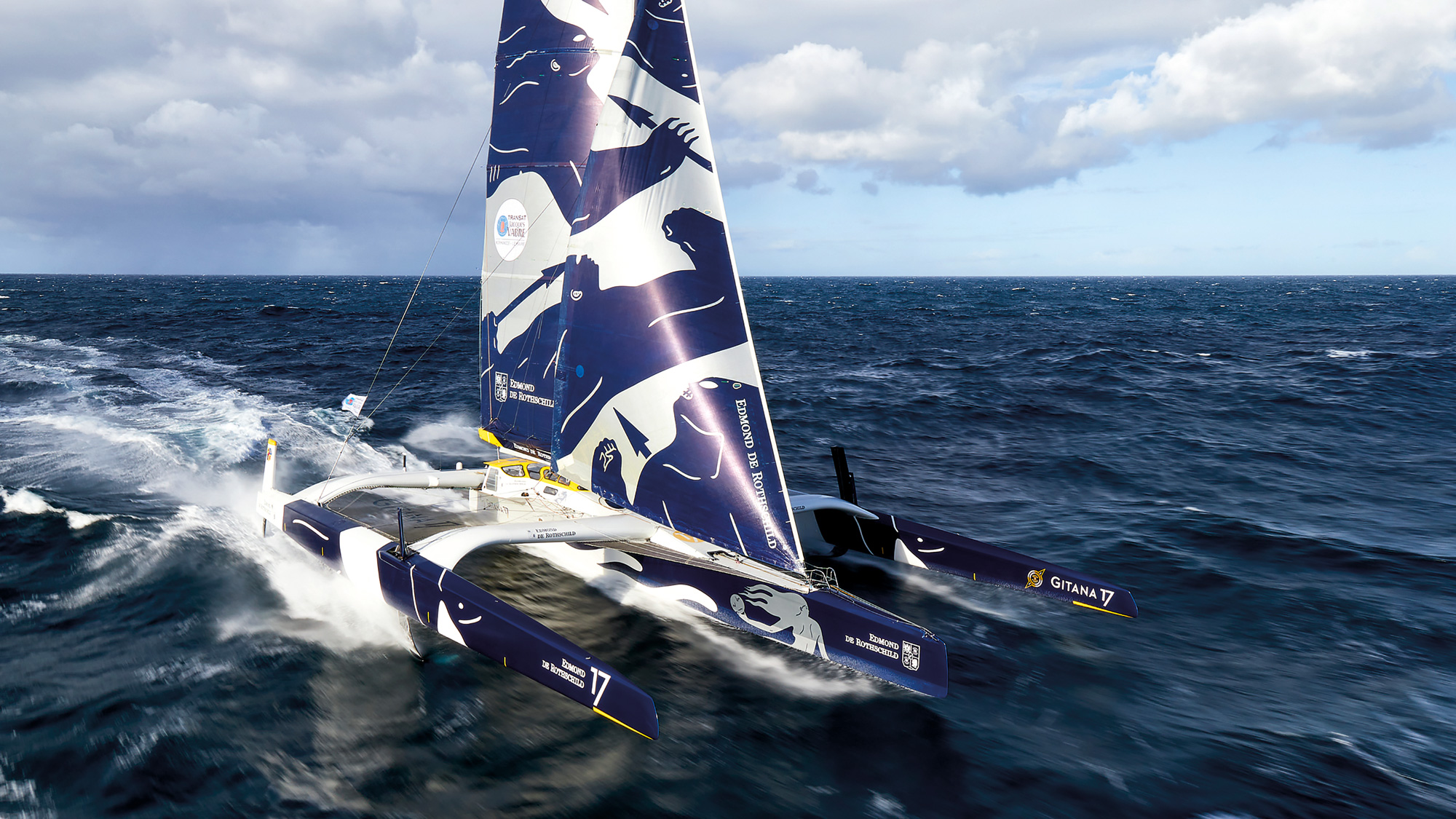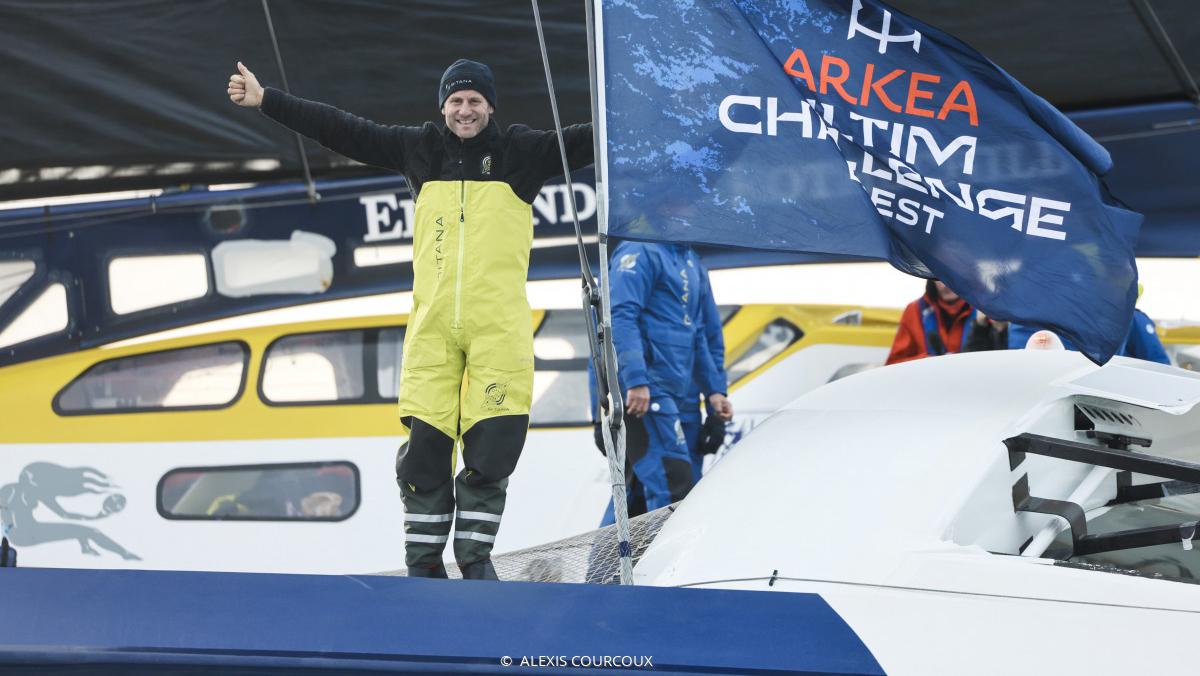“The Ultimes to me are the most technologically advanced and fastest boats that you can still go offshore with, at…
Charles Caudrelier: the first man to foil a Giant multihull around the world
First to foil a Giant multihull around the world, Charles Caudrelier has moved the bar in offshore racing. Helen Fretter finds out how he got there

It would be a scene worthy of the most outrageous Hollywood action movie: a man, alone on an enormous flying trimaran, is hurtling across the ocean’s remotest reaches, when he plunges through the floor of the cockpit. He dangles, metres above the churning waves – with no way of calling for help – until he manages to haul himself back on board. Then he dusts himself off, and keeps racing. But Charles Caudrelier barely mentions it.
“You had some wave damage?” I ask during our chat about the Arkea Ultim Challenge Brest, the solo around the world race in 100ft foiling Ultims.
“Oh, yes. Before Cape Horn, I caught some 7m waves and with the wind churning and the waves coming off a front for a few hours that was quite uncomfortable. A wave onto the back of the boat hit the deck, so I had a big hole in my boat. That was quite difficult, because you feel safe in your cockpit and then suddenly your cockpit is open and you can see water.
“I nearly fell in the water because I forgot that the hole was there. When I came back from doing a manoeuvre, I walked on the hole, because there was still one skin of carbon, but it was like a piece of paper. So I dropped in the hole up to my shoulders, and I managed to catch something and stay on board.
“At this moment I thought about all the hours I spent on the Volvo Ocean Race, outside, waves coming over the deck. And I say, okay, this is nothing compared to that. Your boat is 10m metres longer and you are inside the cockpit, you just have a hole. No worry, everything is going to be fine.”

Photo: Marin Le Roux/polaRYSE/Gitana
It was fine. Caudrelier went on to win the Arkea Ultim Challenge, sailing around the world in 50 days. In doing so he set a litany of firsts: first to foil around the world on an Ultim; winner of the first solo around the world race in multihulls; and takes a unique place as having won both a solo around-the-world race and a crewed around-the-world race as skipper.
Solo sailing goals
Charles Caudrelier, now 50, was born in Paris but the family moved to Brittany so his father could pursue his twin passions of sailing and horses. “When I was two, he decided to leave Paris for another life, which was quite courageous, because his job and all his family were in Paris,” recalls Caudrelier.
The young Charles got involved in sports ranging from golf to fencing and windsurfing, but remembers a pivotal moment when he decided his future was in sailing.
“My father was crazy about offshore racing, and we would go to all the starts of the famous races. One day, I think I was 15, it was the beginning of the one-design solo Figaro. It was also the start of the story of Michel Desjoyeaux, Jean Le Cam, all these guys. He introduced me to Michel and said, this guy will become a great sailor. Michel became my hero, and I started sailing more.

The Caudrelier family moved from Paris to Brittany, and immersed themselves in sailing and windsurfing. Photo: Courtesy of Caudrelier family
“I just wanted to sail single-handed. Sometimes I stole the boat belonging to some friends of my father, and would go sailing in the night trying to sail single-handed on it. It was really what I wanted to do.”
It’s a trait Caudrelier has shown throughout his career – putting the work in, trusting the process – with flashes of risk-taking when required. But the returns weren’t ever guaranteed.
“At this time it was difficult to be a sailor. Nobody was winning money and my father was a bit worried. He told me: finish your studies and after you can do what you want. But I was sailing more and more, doing the Tour de France a la Voile. When you are a young guy, motivated – and people don’t need to pay you! – famous people started to ask me to sail with them. That’s when I met Franck Cammas, and with Franck we did a lot of match racing, so I started to learn how to be very accurate and good at trimming, and as a tactician.”
Article continues below…
Caudrelier wins first ever solo round the world race in foiling Ultim
Solo skipper Charles Caudrelier has won the Arkea Ultim Challenge Brest, the first ever solo around the world race in…
Having left school he completed his French military service (compulsory until 1996) as an athlete, training at Port-la-Forêt, then took part in his first Solitaire du Figaro, where he finished 9th and 1st ‘bizuth’ or rookie. But when he lost his first sponsor, Caudrelier went back to the day job. “My job was at a merchant ship academy, so I went to work on the Brittany Ferries. But after six months, I was going crazy and said, okay, that will not be my life! I will do whatever I can, but I want to win the Figaro.”
After double-handing with Olympic sailing and Figaro legend Gildas Morvan, Caudrelier secured a new backer, and began to move his way up the Figaro rankings: 5th in 2001, 3rd a year later, before winning in 2004. But even then there were still no guarantees of success.

Caudrelier was inspired to sail solo aged 15, even ‘borrowing’ a family friend’s boat overnight to practice. Photo: Courtesy of Caudrelier family
“Now, people prefer to be good on Instagram than trying to win the Figaro! Lots of sailors are on the start of the Vendée Globe, who never succeeded in the Figaro, just find a sponsor because they are good in the media.
“At the time, when I started, if you wanted to have a big boat and do the Vendée Globe, the first step was to win the Figaro. So I did. Unfortunately, I never found a sponsor for myself.”
High performer
Though Charles Caudrelier might not have had his own campaign, the opportunities kept coming. “I was lucky that I joined the best team – Banque Populaire with Pascal Bidégorry – and did all the races in the Orma 60 multihull,” he recalls. “My phone was ringing a lot.”
He co-skippered Marc Guillemot’s innovative Safran IMOCA 60, winning the double-handed races they entered. “That was the first time somebody used this title in France of ‘performer’ [performance analyst]. I was in charge of performance for him.

Racing double-handed in the IMOCA Safran. Photo: DPPI Media/Alamy
“Then my phone rang again, and it was Franck calling me to join the Groupama Sailing Team. That was an amazing experience with top level guys, top design. But it was very tough.”
Groupama, with a Juan Kouyoumdjian-designed Volvo 70 and talent-packed crew (including fellow Ultim skipper Thomas Coville) won the 2011 Volvo Ocean Race, despite a dismasting.
“I learned so many things. I learned how to be a specialist, because as a single-handed sailor I could do everything on the boat. But at the beginning, it was difficult for me to concentrate on one thing. So I learned to do the pitman [role], to do manoeuvres.”
The campaign also had a strong performance development team led by Yann Riou with Charles Caudrelier. “We tried everything. During two years of preparing we did so much work with the designer, there were so many smart people in this team. I have the feeling that I learned more in two years than in 10 years of my sailing life before.
“I learned also to manage people. And I realised that even if you have the best people, if they don’t manage to work together, and if you don’t have a good team spirit, it doesn’t work. That was quite a difficulty inside the Groupama team sometimes.”
It was something Caudrelier prioritised when he was appointed skipper of Dongfeng Race Team for the Volvo Ocean Race. “When I created the team with [team manager] Bruno Dubois, I told him it’s all about human performance, it’s all about working together. And I can say that it’s a success – not only because we won (in 2017/2018). From the Groupama Sailing Team, I speak with nearly nobody. But the Dongfeng Race team – we still have the same WhatsApp group and nobody left it.

Firehose conditions on the Dongfeng VO65. Photo: Eloi Stichelbaut/Dongfeng Race Team
Each time there is a birthday or something important, like a baby – or a rugby match! – everybody makes jokes. I think in 20 years we will still be in contact.”
Another key tenet of the Dongfeng campaign was that the crew looked after each other. Caudrelier recalls that when Dongfeng made their final race-winning decision to take a daring inshore route to the finish in The Hague, no other team had spotted the opportunity. “When we spoke to the other guys they said, ‘Oh, I was exhausted, we didn’t think about it.’
“We worked a lot on the routing, probably because we were not exhausted. And nobody was exhausted because we had good food, we were in good shape. Some other crews had skin problems, foot problems – because they didn’t think this stuff was so important. We had very heavy mattresses; people were laughing at us, saying it’s too heavy – but not if you sleep better. The small details make a difference.”

Celebrating Dongfeng’s Volvo Ocean Race win with crew mate Carolijn Brouwer. Photo: Eloi Stichelbaut/Dongfeng Race Team
Big questions
Despite Caudrelier’s no-stones-unturned approach, the Arkea Ultim Challenge harboured a great number of unknowns, not least uncertainty about whether the 100ft foiling Ultims could even make it around the course.
“I was very confident – and I’m never confident, that’s not me. But I’m also Cartesian,” he says, referring to the mindset that allows you to rationalise two opposing truths. “I was thinking, okay, I know my boat is stronger than the others. I was sure about that. I know we have more experience. Nobody has sailed as much as me on this kind of boat.
“But I was not sure that one boat would finish the race, to be honest, because we tried two times with the Trophée Jules Verne and we broke something every time.”
The Verdier-designed Maxi Edmond de Rothschild, Gitana 17, was launched back in 2017. Seven years is a long time to be at the cutting edge, but its deep development programme has enabled Caudrelier, together with former co-skipper Cammas, to become the dominant force in the Ultim class, winning Fastnet Races, the Transat Jacques Vabre, and the double-handed Brest Atlantiques race – a proof of concept event for the foiling trimarans (which proved, ultimately, that they could race trans-ocean, but probably not non-stop).
Finally, in 2022, Caudrelier got his single-handed ocean race win when he took 1st in the Route du Rhum – a boyhood dream come true.
“I think because Gitana were the first to make the step of flying offshore it was a huge advantage that we still have in the game,” says Caudrelier. “Today, it’s very close in terms of performance. But I was sure that I have the boat that is the most reliable. I know that my boat is a bit heavier than the others – because it’s stiff, that’s the first reason. But also because we think systems need to be strong to last. And that’s what happened. Everybody had rudder system [problems]. We already had all these problems with rudders two years ago. So I knew that I could push.”

The Arkea Ultim Challenge Brest saw six 100ft trimarans race around the world solo, but only Caudrelier nearly made it non-stop. Photo: Vincent Curutchet
Breakneck pace
And push he did. The early stages of the race were breakneck with Charles Caudrelier and Tom Laperche on SVR-Lazartigue locked into a battle at 30 knots, often less than two miles apart. For followers it was riveting, but on board it was relentless.
“We were racing like we were with crew. We were dropping the sail at full speed, hoisting at full speed. We were trying to lose nothing. Each mile was important, which, I think, could have been our mistake. If Tom hadn’t broken his boat [SVR-Lazartigue retired into Cape Town after an underwater collision], maybe we would have been stupid and pushed together too far. But yeah, that was quite impressive…”
It’s a work rate Charles Caudrelier is known for. He has the reputation for being a machine. “It’s what my routing guys call me,” he explains, “because when I did the Route du Rhum, I was doing the same performance as the crew, and when they asked me to do a tack or manoeuvre, I never say no.” (During his six day transatlantic he made 17 gybes and 15 tacks).

Co-skippering with his close friend, Franck Cammas. Photo: Alexis Courcoux/Brest Atlantiques
“But I’m just very well organised. I don’t like to say where I’m good, but I think I’m very good at manoeuvres. I’m not a guy who’s organised in real life, but when it’s about manoeuvring, I always have a good plan, and I really want to do it perfectly. Tom is also a machine. I thought nobody will follow me at the beginning – Tom did, but he’s 25 years younger!”
By the time Caudrelier returned to the North Atlantic, he was the only one of the six skippers not to have made a technical stopover for repairs. Besides the hole in the cockpit sole, Gitana 17 had suffered early wave damage to the front crossbeam, and later mainsail damage, both of which Caudrelier was able to fix on the fly. Before and after Cape Horn he had slowed to avoid severe weather systems, but the forecast for the final approach to Biscay was impassable: 50-knot winds and 7-10m waves.
“So we stopped in the Azores. That was my decision. I didn’t want to stop, actually, and the team didn’t want me to stop. But at one point, it’s all about ego. What is the smartest thing to do?
“If I’d had a boat behind me, I would have gone, it was not impossible. But the only goal was to win the race, so why take so much risk? The mast was my big worry, because I can break a foil, I can break a rudder, I will finish. But if I break the mast, I cannot finish. So I said, okay, I don’t want to take this risk.”

Huge crowds turned out to welcome Gitana back to Brest. Photo: Loïc Venance/AFP/Getty
Ego is not something that drives Charles Caudrelier. I ask if the significance of his win has sunk in?
“No. I always see myself as a kid who had dreams. I’m 50 today, so people call me the old guy, but in your mind, sometimes you’re still the same person that you were when you were 20 or 15.
“I am proud about it. But I never forget that because I became skipper very late – I was 40 – you need a bit of luck in this sport. I try to stay humble. Of course it’s amazing, but it’s not only about me. Even if I was single-handed, it’s a team job. And I am lucky to be in the best team. Without them, I’m nothing.”

Caudrelier meets the crowds at the end of the Arkea Ultime Brest. Photo: Eloi Stichelbaut/polaRYSE/Gitana
What next for Charles Caudrelier?
The Gitana team has a new Ultim in build. They’re yet to release any details, but have been clear that radical ideas were on the table, in search of a radical performance gain.
“I think it’s possible to go much faster, especially on the waves. That’s the goal of Gitana 18. On flat water we know how to do it, but on the waves It’s much more complicated,” says Caudrelier.
“Unfortunately, we cannot do a wing sail. Today, we know where we could win a lot is by doing a wing. But it’s not possible because of the rules, and it’s also probably not possible today in terms of techniques, because you need to take reefs and so on. But one day it will happen, because I think the ‘engine’ of the boat with soft sails is not so good.”
Gitana 17 is up for sale, though Caudrelier says they could make another Jules Verne attempt. Otherwise he will aim to defend his Route du Rhum in 2026, but has no ambitions to sail the next Ultim around the world.
Instead he wants to work more closely on the design side, and help bring on a new skipper (none have yet been named).
“I realised today that the race is over,” he says, having just returned from a long-awaited holiday. “My brain was never free because I was always thinking about this race. And today I think I’m more available for my family than I was before. I don’t want to go again for another cycle.”
 If you enjoyed this….
If you enjoyed this….
Yachting World is the world’s leading magazine for bluewater cruisers and offshore sailors. Every month we have inspirational adventures and practical features to help you realise your sailing dreams.Build your knowledge with a subscription delivered to your door. See our latest offers and save at least 30% off the cover price.
The post Charles Caudrelier: the first man to foil a Giant multihull around the world appeared first on Yachting World.



